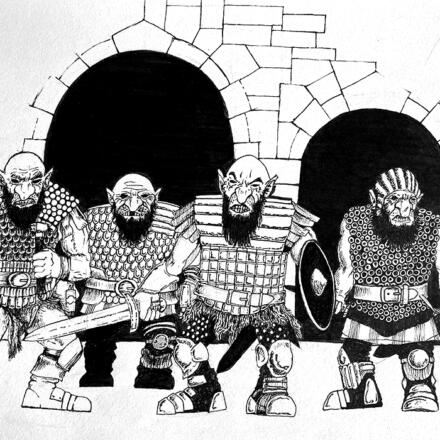You established what an epic campaign is for your group with act one, and you threw the PCs a few curveballs with act two, but now it is time to wrap up your campaign and this series of articles with act three! It is time to settle things once and for all between the heroes and the evil mastermind.
Bring Back The Most Memorable NPCs From Previous Sessions
The first part of act three is all about establishing that this will indeed be the final act. Whether or not that means the PCs are retired from play is up to you and your group, but I have found that great epics conclude the stories of great characters. If there are any loose threads to tie up make sure to bring those NPCs into act three. They do not have to have their presence known at the beginning of the act. You can introduce them at different points in the story. Just be sure to close any plot points associated with these characters.
Your choices are not limited to NPCs from acts one and two. If your PCs were adventuring before the epic campaign began you can bring back NPCs from any point in their established history. In fact, a great twist is to reveal that the evil mastermind is actually a villain that the PCs defeated early in their careers. As long as your players remember the NPC that is all the reason that you need to bring that character back into the game.
You also are not limited to using the actual NPC. This might seem like a contradiction, but the point of bringing characters back is so that you can conclude their stories before concluding the PCs’ stories. You can declare that an NPC died, but you need to explain how it happened. You can replace an NPC with one of their children, but you need to explain why. As long as there is closure for the original NPC’s story then you can replace, maim, kill, retire, or do whatever else you want. Just make sure those stories have endings, or that they will come to an end during act three itself.
Why Did It Come To This?
By this point in the story the players will know how the events transpired, but it is possible that they will not recall why. They know that the evil mastermind attacked. You need to remind them why the evil mastermind attacked, and you need to remind the players why their PCs fought back. Introduce some survivors of the first wave of destruction, or even better some escaped prisoners who risked life and limb to get back home. They should tell of the horrors that they faced at the hands of the mastermind, and they should thank the PCs if applicable.
You should also have some NPCs who are ready to quit and run. These are not cowards. These are people who have lost hope. There is a big difference between the two. Cowards will avoid a fight, but a person without hope sees no purpose behind fighting anymore. Perhaps the PCs can convince these characters to give it one last try, but the willingness of these NPCs to give up and retreat should establish just how bleak the situation is.
If the true reason for the evil mastermind’s actions have never been revealed, then now is the time to reveal them. Do not wait until the climactic final battle. By then it will be too late. You want the PCs to be motivated before that happens. Even if the mastermind’s true intentions have been known all along there is one key piece of information that you must reveal at this point: the way to win.
Maybe you have laid clues throughout the first two acts, or maybe your players just came up with a great idea on their own. It does not matter who or where the solution came from. It does not matter if you planned the solution or not. You need to make it clear to the players that there is a way to achieve victory, and that the PCs have everything that is needed for such an undertaking. There is just one catch —
It Is Now Or Never!
The heroes must make their move. The fate of everything that they hold dear hangs in the balance. It is time to take action against the mastermind. Pack some bubble gum, strap on your ass kicking boots, and cue O Fortuna. This is the part where heroes become legends.
Your game system will determine how this part of the act works out. If your system of choice relies heavily on miniatures then arrange for a massive battle and have simplified combat rules ready for conflicts between NPC cannon fodder. The only fully detailed characters should be the PCs, the mastermind, and a few loyal henchman if any. Give control of the PCs’ allies to your players and let the dice take it from there.
Make the battle dynamic though. Do not have the final conflict take place in a field. It should be on a mountain top, at the gates of heaven, or in a space station orbiting a star that could go supernova at any moment. Make the battlefield a third force to deal with during this final battle, and it favors no one.
If your system of choice is instead more story driven then focus on the PCs and the mastermind, but use the large scale battle that rages on around them as a living background. Describe wounded dragons crashing out of the sky into catapults loaded with flaming casks of oil. Put emphasis on how the building trembles with every burst of the alien ray guns as their hovertanks fire upon various targets. Even if the PCs and the mastermind are nowhere near this action have some form of communications reporting the carnage as it unfolds. This will just put greater emphasis on how the heroes are fighting for something greater than themselves.
However the story resolves between the heroes and the mastermind it should coincide with the larger battle going on all around them. Think of how the duel between Darth Vader and Luke Skywalker in Return of the Jedi was heightened by the battle to destroy the Death Star. You want that kind of synergy between the large battle of the two opposing sides and the personal confrontation between the mastermind and the heroes.
And when it concludes, announce the mastermind’s demise by blowing something up.
Like Staring Into The Sun From The Surface of Mercury
Yes it is a cliché. So what? It works, and it works for a reason. Blowing up the big bad guy’s base, turning the Kraken into stone and watching it shatter, or watching Sauron’s eye suddenly go ka-boom is a hell of a lot more satisfying to have happen then for the mastermind to go out with a whimper.
It does not have to be an actual explosion, but it should be something with an explosive quality to it. Connor MacLeod saying “There can be only one!” and then receiving the Quickening in Highlander is a good example. Yeah some lights exploded in that scene, but the real action was the visual depiction of him receiving the prize that he had fought over 400 years to obtain.
Another reason to have a big explosive ending for the climactic battle is so that you can conclude the story with the heroes in a peaceful setting. After the bad guys are dealt with you want the heroes of the story to have their epilogue. This should be everything that the struggle was not. The heroes should be able to relax and soak in the happiness of all those around them who are now free to pursue their normal lives again. This is when the story comes to an end. We want to close the book, leave the theater, and exit the playhouse knowing that the heroes lived happily ever after.
Anyone Can Make Macaroni & Cheese From A Box
This three part series has presented to you a formula to use for an epic campaign. It is like a recipe, and like any good recipe it can be altered as needed. Use the parts that work for you, and ignore the bits that do not. Or follow it by the letter the first time and then alter it to your particular tastes the next time you use it.
As a GM you know better than anyone else what your gaming group wants out of its sessions, so if you know of a way that you can take this formula and improve upon it you absolutely should do so. It will only help you in the long run.
I hope that you enjoyed this series, and I also hope that you will share your ideas and opinions on how to run an epic campaign with the rest of us by leaving a comment below. Share your tips and tricks with other GMs, and good luck with all of your campaigns!

















That section on NPC motivations is spot on. Maybe in the big picture it doesn’t really matter why some characters will cut’n’run … but identifying that NPCs do things for their own reasons irrespective of party goals and intent can help solidify and organize events from the GM’s perspective.
Well, that was a run-on sentence. I’ve enjoyed this series, Patrick.
@Troy E. Taylor – I’m glad that you liked it. I’m with you on NPC motivations, and I think that one of the greatest things that can occur in a game is for the PCs to unify NPCs against a common threat. It should take work and a lot of effort, but there is a sense of accomplishment there that is hard to duplicate.
Excellent finale.
I think when you look at an Epic game one of the things about it, is that the are some things you do no matter how cliche it is. While I think you could go some length to try to avoid the big explosion, why bother? Deep inside, everyone loves the big explosion.
Great advice.
@DNAphil – Good point. There is nothing wrong with doing something just because it is expected. Instead of putting energy into avoiding the “big explosion” you are better off putting your own unique spin on that event.
I loved this series. I also really enjoy the timing with the artilce about hard and soft scenes. These are perfect to mix into an epic campaign to keep the pace going. The soft scenes also provide ways to wrap up the NPC who were intorduced, but not critical. I am using this epic campaign formula in my next game.
@Razjah – Umm, of course this series and that hard and soft scenes article go great together! Walt and I planned it this way! We gnomes are geniuses! Hear that? Geniuses!
🙂
Great catch on how this formula can correlate with other tactics, such as the hard and soft scenes. We GMs should always use combinations of tools and tricks to get the most out of our games.
I enjoyed the whole series. I printed it off, and compared it to the next campaign I am planning. That clarified some things, and I was pleased to see that I had more than half of the elements in place already. I just need to work in the NPCs more tightly, as well as a Rival team.
Thanks again.
How to have an epic DM advisory in three posts. Great, workable, inspiring framework that makes me want to run a summer campaign for my friends’ old characters. Copied and pasted almost every bit of it. Thank you.